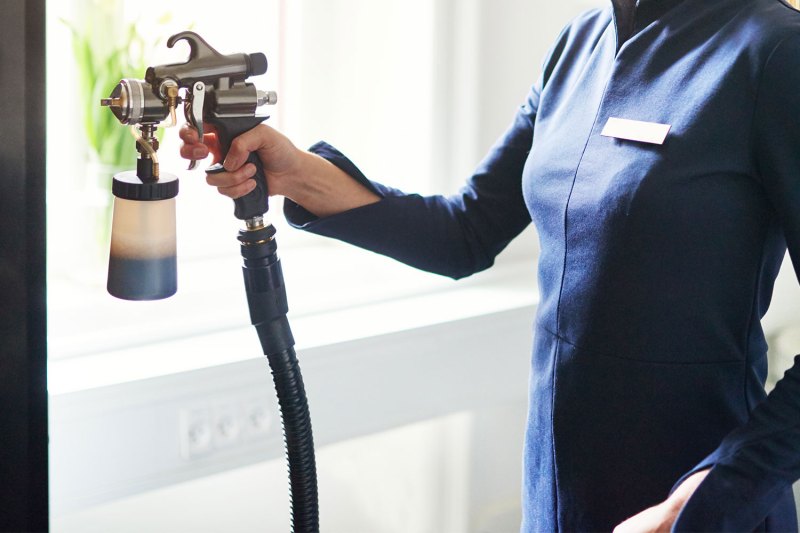While nothing can replace absorbing a little of nature’s vitamin D from the sun itself, it’s been proven that extended exposure can damage our skin, cause premature aging, and make us susceptible to skin cancer.
With that said, not all of us are gifted with naturally pigmented skin. However, the good news is that we all can achieve that perfect sun-kissed appearance, if but for only short periods of time. Spray tanning is a healthy and easy way to maintain the perfect tan, potentially without a single tan line. And, there are literally no drawbacks to the process, unlike the alternatives of tanning beds and prolonged exposure to nature’s UV light.
So, I assume you’re wondering what makes this largely outdoor and adventure travel writer an expert in spray tanning? Well, being an expert is only partially true. Here’s why I acquired this new skillset.

My wife is a television news anchor and there is an element of perceived image in the business. In addition to her duties as an anchor, she is quite often asked to emcee and attend events in which the dress code requires evening gown attire. After years of having spray tans applied at local vendors, we opted to invest in the equipment for use at home. And while I don’t advise this for everyone, it was the right direction for us as it provided freedom from financial and time constraints. After watching a number of online videos (you truly can learn how to do just about anything online) and engaging in a couple of trial runs, we were in “business” and able to apply the proverbial tanned look at our convenience.
Here is our guide for achieving that perfect faux glow before your next date, event, or just to prevent that perpetual pasty appearance heading into the winter season.
What is Spray Tanning?
Spray tanning is a process by which a light mist of the chemical called Dihydroxyacetone (more commonly referred to as DHA) is sprayed across the body, causing the skin to turn several shades darker. This chemical has been used for several decades in the cosmetic industry and is considered safe for perpetual use. This is ideal as the effects of the applied misting typically only last for approximately a week. Therefore, if you desire to maintain your newfound skin tone, it will require almost weekly applications. Also, it is generally recommended to get your spray tan two days prior to when you need it. Sessions can range from $25-$50 while some salons offer discounts when purchasing a fixed number at a time. Purchasing ahead can reduce the overall cost when regular applications are desired.
Prepping Is Paramount
As the tanning process occurs on the outer layer of skin, it’s essential to prepare for your appointment to achieve the best results.
• Exfoliate at least 12 hours prior to your appointment. It’s important to focus on areas of the body that might be especially dry like knees, hands, feet, and elbows. This includes shaving as this is a form of exfoliating.
• Avoid the use of lotions, moisturizers, and deodorants.
• Shower prior to your appointment.
What to Wear
On the day of your appointment, avoid wearing tight clothing. Instead, choose to wear loose-fitting apparel options as this can rub away part of the spray tan before it has time to set. Also, choose to wear dark clothing to prevent the discoloration of your clothes.
Once you have been called back for your appointment, you will be instructed to remove layers of clothing that correspond with your level of comfort. If you have no desire to get completely nude, wear underwear (or a swimsuit) that you don’t mind possibly getting stained.
What To Expect
Most salons offer a barrier cream that can be applied to fingernails (especially the cuticles) and other areas that are naturally lighter (soles of your feet and the palms of your hand). It’s also possible that you will be offered disposable paper footwear that adheres to the bottom of your feet. Wearing a hair net can prevent staining as well. Wearing lip balm can also prevent the mist from entering your mouth. Placing cotton in your nostrils can also prevent accidental inhalation of the mist.
After Your Spray Tan
The spray tan generally develops 4-6 hours after your session. Therefore, it’s important to avoid showering or bathing for at least 12 hours after your session. Sweating can also have detrimental effects on the efficacy of the spray tan. Therefore, it’s best to avoid activities that first day that might cause perspiration. Swimming pools that contain chlorine can be detrimental to your faux glow.
Try to avoid manicures and pedicures when possible as the chemicals used can often strip away your tan.
Maintenance
As mentioned earlier, spray tans can last up to seven days. However, it is possible to extend the results slightly longer. Salons often offer a variety of moisturizers that when applied daily, can extend the life of your newly acquired pigmentation.


